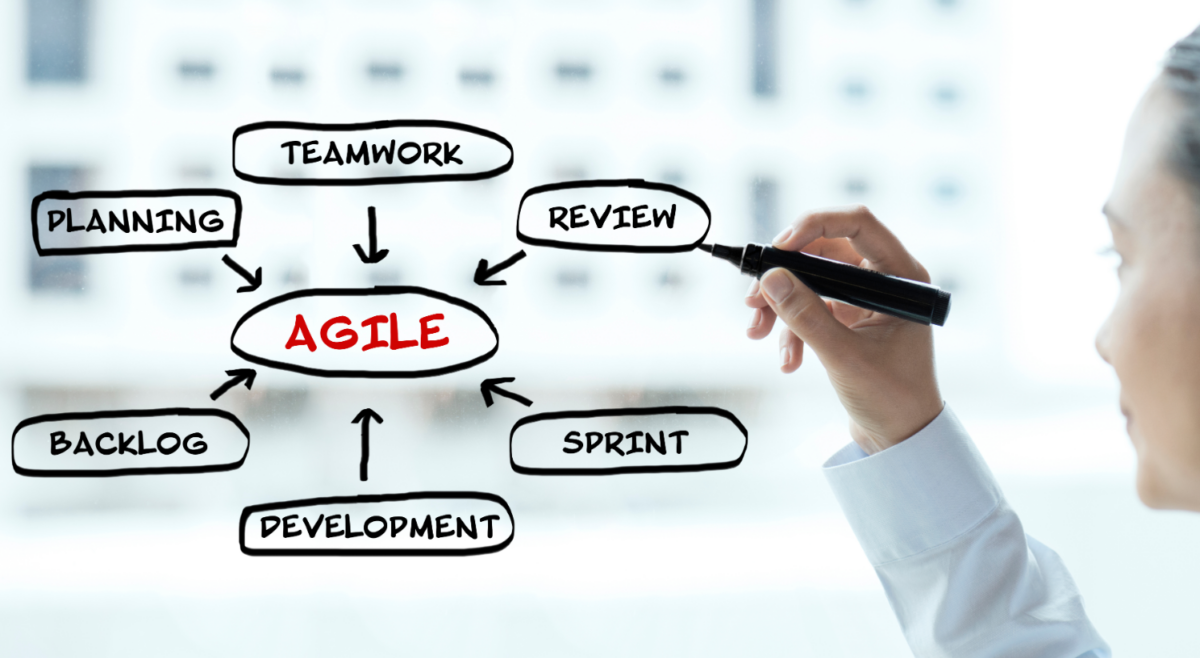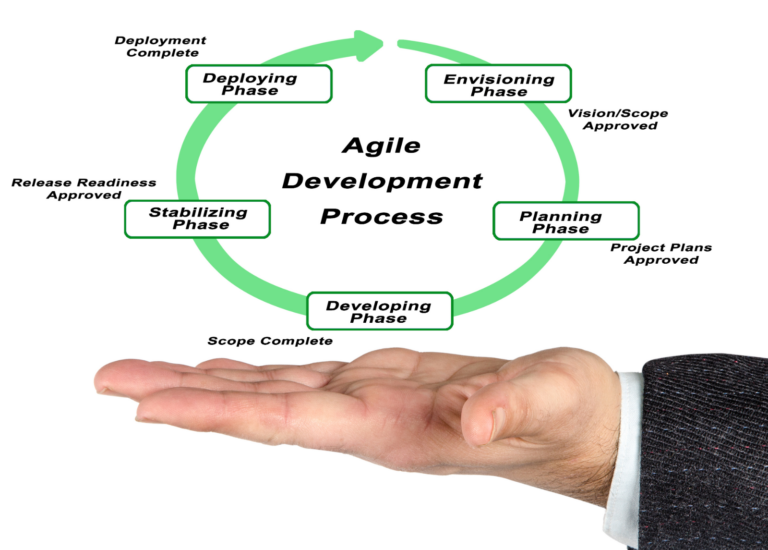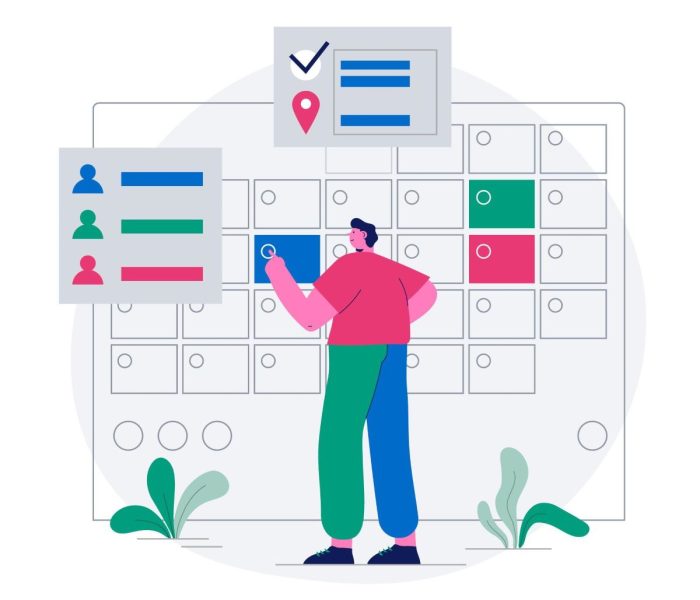
Table of Contents
Introduction to Agile Web Development
Agile web development is a methodology that emphasises flexibility, collaboration, and customer satisfaction in the software development process.
It originated from the Agile Manifesto, created in 2001 by a group of software developers who sought a more efficient and effective approach to software development.
This manifesto laid the foundation for Agile methodologies by prioritising individuals and interactions over processes and tools, working software over comprehensive documentation, customer collaboration over contract negotiation, and responding to change over following a plan.
These core values and principles guide Agile methodologies, shaping a dynamic and iterative approach to developing software, including web applications.
In the modern web development landscape, the importance of Agile practices cannot be overstated.
The technological environment is characterised by rapid changes and advancements, making it crucial for development teams to be able to adapt quickly to new requirements and market demands. Agile methodologies facilitate this adaptability by promoting continuous feedback, iterative development, and cross-functional collaboration.
This approach allows teams to deliver high-quality web applications more efficiently, meet customer needs more effectively, and stay competitive in a fast-paced industry.
The benefits of Agile methodologies, including reduced development time, increased project control, and improved customer satisfaction, make it a preferred choice for many web development projects today.
Core Principles of Agile Web Development
Agile web development is fundamentally built on the principles of iterative and incremental development.
This approach divides projects into smaller, more manageable segments known as sprints or iterations, each with a specific set of goals and deliverables.
The iterative nature allows for the development process to be cyclical, with each cycle involving planning, execution, and evaluation.

This methodology enables teams to adapt to changes quickly, incorporate feedback effectively, and make necessary adjustments without disrupting the overall project timeline. The incremental aspect ensures that each part of the project builds upon the previous, gradually enhancing the product’s features and functionality.
The benefits of this approach are manifold, including increased project flexibility, improved product quality through continuous testing and feedback, and the ability to deliver value to the customer at a faster pace.
Collaboration and communication are the cornerstones of Agile web development, emphasising the importance of team dynamics and stakeholder involvement. Agile teams are encouraged to work closely together, fostering an environment of transparency, trust, and mutual respect.
Regular communication, through daily stand-ups, sprint reviews, and retrospectives, ensures that everyone is aligned on the project goals, progress, and challenges.
This collaborative approach not only enhances productivity but also ensures that the final product aligns closely with customer needs and expectations. To facilitate effective teamwork and stakeholder engagement, Agile teams often employ various tools and practices, such as project management software (e.g., Jira, Trello), instant messaging platforms (e.g., Slack), and video conferencing tools (e.g., Zoom).
These technologies enable seamless communication and collaboration, both within the team and with external stakeholders, thereby driving the project towards successful completion.
Key Practices in Agile Web Development
In Agile web development, sprint planning and execution are critical phases that dictate the pace and direction of project development.
Sprint planning begins with defining the sprint goal, which is a concise statement of what the sprint aims to achieve. This is followed by the selection of tasks from the product backlog, which are then prioritised and assigned to the sprint backlog.

The Scrum Master facilitates this process, ensuring that the planning meets the team’s capacity and sprint goals, while the Product Owner is responsible for the sprint’s content, prioritising tasks based on business value.
During the sprint, daily progress is monitored, and adjustments are made as necessary.
The sprint ends with a sprint review, where the team demonstrates what they have built, and a retrospective to reflect on what can be improved in the next sprint.
Daily Stand-ups
Daily stand-ups are a staple in Agile web development, serving as quick, daily meetings where team members synchronise their work and report on obstacles.
Typically lasting about 15 minutes, these meetings involve each team member answering three questions: What did I accomplish yesterday? What will I work on today? What obstacles are impeding my progress?
This structure promotes transparency and immediate issue resolution, as team members can quickly identify and address blockers, ensuring continuous progress and adherence to the sprint timeline.
Continuous Integration and Deployment
Continuous Integration (CI) and Continuous Deployment (CD) are practices that automate the integration and deployment of code changes, allowing for frequent and reliable releases.
CI involves developers merging their changes back to the main branch as often as possible, where automated builds and tests run to ensure that these changes do not break the project.
CD extends this by automatically deploying all code changes to a testing or production environment after the build stage.
Tools like Jenkins, Travis CI, and CircleCI facilitate these processes by automating testing and deployment, significantly enhancing development efficiency by reducing manual tasks and minimising integration issues.
These practices not only streamline development workflows but also help maintain a high standard of quality and rapid delivery in Agile web development projects.
Agile Frameworks and Methodologies
Agile software development encompasses a range of frameworks and methodologies, each with its unique approach to delivering high-quality software iteratively and incrementally.
Among the most widely adopted frameworks are Scrum, Kanban, and Extreme Programming (XP).

Scrum is a framework that emphasises teamwork, accountability, and iterative progress toward a well-defined goal. It revolves around short, time-boxed iterations called Sprints, during which a cross-functional team works to deliver a potentially shippable product increment.
Scrum defines specific roles, events, and artifacts to facilitate collaboration, transparency, and continuous improvement. Key elements include the Scrum Master, Product Owner, Sprint Planning, Daily Scrums, Sprint Reviews, and Sprint Retrospectives.
Kanban, on the other hand, is a lean methodology that focuses on visualising the workflow and limiting work in progress (WIP). It utilises a Kanban board to represent the various stages of the development process, with tasks represented as cards that flow through these stages.
The emphasis is on continuous delivery, minimising bottlenecks, and maximising efficiency through the principles of visualisation, limiting WIP, and continuous improvement.
Extreme Programming (XP) is a disciplined approach that emphasises high-quality software through a set of values, principles, and practices. It encourages frequent releases, continuous integration, test-driven development, pair programming, and close collaboration with customers.
XP values simplicity, communication, feedback, and courage, aiming to deliver working software frequently and respond quickly to changing requirements.
Differences among the Frameworks
While these frameworks share the core principles of Agile software development, they differ in their specific practices and areas of focus:
Scrum: Emphasises iterative planning, time-boxed Sprints, and well-defined roles and ceremonies.
Kanban: Focuses on visualising the workflow, limiting WIP, and continuous delivery.
Extreme Programming (XP): Prioritises technical practices, such as test-driven development, pair programming, and continuous integration, to ensure high-quality code and responsiveness to change.
The choice of framework often depends on the project’s complexity, team dynamics, and organisational culture.
Some teams may adopt a single framework, while others may combine elements from multiple frameworks to create a tailored approach that best suits their needs.
Tools and Technologies Supporting Agile Web Development
Agile web development relies heavily on a suite of project management and collaboration tools to streamline processes, enhance communication, and ensure efficient project tracking.
Among the most popular tools are JIRA, Trello, and Asana.
JIRA, developed by Atlassian, is renowned for its robust capabilities in backlog management, sprint planning, and real-time collaboration. It allows teams to create and prioritise user stories, track progress through interactive timelines, and integrate seamlessly with other development tools.
Trello, on the other hand, offers an intuitive Kanban-style board that is particularly favored by smaller teams and startups for its simplicity and ease of use. It enables teams to visualise tasks, move them through different stages of completion, and collaborate effectively.
Asana provides a versatile platform that supports various project management methodologies, including Agile. It features task boards, calendars, and Gantt charts, making it easy for teams to organise work, track progress, and maintain alignment across different functions.
Key Features of Popular Agile Project Management Tools
Tool | Key Features | Ideal For |
JIRA | Backlog management, sprint planning, real-time collaboration, integration | Both small and large-scale projects |
Trello | Kanban boards, task visualization, simplicity, ease of use | Smaller teams, startups |
Asana | Task boards, calendars, Gantt charts, versatile project management | Various project sizes and types |
Version control systems (VCS) are indispensable in Agile web development, providing a structured approach to managing changes in the codebase.
Git, a distributed version control system, is particularly favoured in Agile environments due to its flexibility, performance, and support for non-linear workflows.
Git allows developers to create branches for individual tasks or features, enabling isolated development and reducing the risk of conflicts. This branching capability is crucial for Agile teams, as it supports continuous integration and deployment (CI/CD) practices, ensuring that code changes are tested and integrated frequently.
The benefits of using Git in an Agile environment include enhanced collaboration, as each developer can work on their local copy of the codebase, and improved code quality through regular code reviews and automated testing.
Furthermore, Git’s distributed nature ensures that the entire project history is available locally, providing resilience and facilitating faster operations.
Benefits of Using Git in Agile Development
Enhanced Collaboration: Developers can work on isolated branches, reducing conflicts and enabling parallel development.
Improved Code Quality: Regular code reviews and automated testing ensure high standards.
Resilience and Performance: Distributed architecture allows for local access to the full project history, speeding up operations and providing robustness against data loss.
In summary, the combination of powerful project management tools like JIRA, Trello, and Asana, along with robust version control systems like Git, forms the backbone of effective Agile web development. These tools not only enhance collaboration and project tracking but also ensure that development processes are efficient, flexible, and resilient.
Benefits of Agile Web Development
Agile web development offers significant benefits, particularly in terms of enhanced product quality and increased project flexibility.
One of the primary ways Agile practices lead to higher-quality web applications is through iterative testing and continuous feedback.
By breaking down the development process into smaller, manageable sprints, Agile teams can conduct frequent testing and gather feedback at every stage. This approach allows for the early detection and resolution of defects, ensuring that issues are addressed promptly before they escalate.
Quality assurance techniques commonly used in Agile include Test-Driven Development (TDD), where tests are written before the code, and Continuous Integration (CI), which involves regularly merging code changes into a shared repository and running automated tests to catch integration issues early.
These practices not only improve the overall quality of the software but also enhance the reliability and maintainability of the codebase.
Quality Assurance Techniques in Agile
Test-Driven Development (TDD): Writing tests before code to ensure functionality meets requirements.
Continuous Integration (CI): Regularly merging code changes and running automated tests to detect issues early.
Behavior-Driven Development (BDD): Using common language to define test cases, ensuring alignment with business requirements.
Automated Testing: Implementing automated tests to cover repetitive and time-consuming tasks, improving efficiency and coverage.
Increased project flexibility is another hallmark of Agile web development. Agile methodologies are designed to accommodate changes in project scope and requirements, making them ideal for dynamic and fast-paced environments.
Unlike traditional waterfall methods, which follow a linear and rigid approach, Agile allows teams to pivot and adapt based on evolving client needs and market conditions.
For instance, if a client decides to change a feature mid-project, Agile teams can incorporate this feedback into the next sprint without derailing the entire project.
Real-world examples of Agile’s adaptability include projects where initial user feedback led to significant changes in the product design or functionality, ultimately resulting in a more user-centric and successful final product.
This flexibility not only enhances customer satisfaction but also reduces the risk of project failure by ensuring that the development process remains aligned with the client’s vision and market demands.
Benefits of Agile Flexibility
Adaptability to Change: Agile allows for adjustments in project scope and requirements without significant disruption.
Customer-Centric Development: Continuous client involvement ensures the final product meets evolving needs.
Reduced Risk: Regular feedback and iterative development minimise the risk of project failure.
By embracing Agile methodologies, web development teams can deliver high-quality, flexible, and customer-focused solutions that are well-suited to the demands of today’s rapidly changing technological landscape.
Challenges and Considerations
Agile development, while highly effective, presents unique challenges when managing distributed teams and scaling large projects.
Implementing Agile practices with remote or distributed teams requires careful consideration of communication, collaboration, and coordination.
One of the primary strategies is to establish clear communication channels and regular touchpoints, such as daily stand-ups, sprint planning, and retrospectives, using video conferencing tools like Zoom or Microsoft Teams.
Additionally, leveraging project management tools like Jira, Trello, and Asana can help track progress and maintain transparency across geographically dispersed teams.
These tools facilitate real-time updates, task assignments, and progress tracking, ensuring that all team members are aligned and informed.
Tools and Techniques for Remote Collaboration
- Video Conferencing: Zoom, Microsoft Teams
- Project Management: Jira, Trello, Asana
- Instant Messaging: Slack, Microsoft Teams
- Version Control: Git, GitHub, GitLab
- Collaborative Documentation: Confluence, Google Docs
Scaling Agile for large-scale web development projects introduces additional complexities, such as coordinating multiple teams, managing dependencies, and maintaining consistent delivery standards.
One of the approaches for scaling agile is the Large-Scale Scrum (LeSS). It offers a streamlined approach to expanding agile practices beyond single teams to larger organisational contexts.
This framework builds upon the core tenets of Scrum, adapting them to coordinate multiple teams collaborating on a unified product. LeSS’s distinguishing feature is its commitment to simplicity, introducing only essential additions to the standard Scrum framework.
It advocates for a holistic product perspective, with all teams working from a shared Product Backlog and synchronised Sprint cycle.
This approach fosters enhanced visibility and minimises inter-team bottlenecks.
Rather than layering on complex structures, LeSS focuses on reshaping organisational dynamics to cultivate agility at scale, thus sidestepping the typical complications that arise when scaling agile methodologies.

Challenges and Approaches for Scaling Agile
Challenges:
- Coordinating multiple teams and dependencies
- Maintaining consistent delivery standards
- Managing stakeholder expectations
Approaches:
- Scaled Agile Framework (SAFe): Provides structured guidance for scaling Agile practices.
- Scrum@Scale (S@S): Creates a network of Scrum teams to manage large projects.
- Large Scale Scrum (LeSS): Extends Scrum principles to large-scale projects.
Organisations can effectively manage distributed teams and scale Agile methodologies to meet the demands of large-scale web development projects by adopting these strategies and leveraging appropriate tools.
Take the Next Step in Agile Web Development
Embrace the power of Agile methodologies with Websparks today. At Websparks, we specialise in harnessing Agile methodologies to deliver cutting-edge solutions that meet and exceed client expectations.
With over 15 years of industry experience, our expertise in Agile web development has helped our clients achieve faster delivery, improved collaboration, and superior quality.
Explore how Websparks can empower your team with Agile strategies tailored to your unique needs.
Contact us on how to embrace Agile principles and transform your web development journey today!


